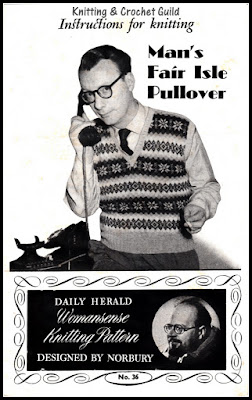One chapter that has caught my attention so far is on Pattern Appropriation - the 'borrowing' of Shetland designs by commercial companies, especially in the 1950s. One of her examples is a shawl that Kate Davies wrote about in The Book of Haps: it appeared in a Patons & Baldwins pattern leaflet, number 893, published in 1951 or 1952. According to the leaflet, the shawl was 'designed by Mrs A. Hunter of Unst'. The original shawl was bought from Mrs Hunter by James Norbury, chief designer for Patons & Baldwins, and is now in the Knitting & Crochet Guild collection.
 |
| Patons & Baldwins leaflet 893 |
It proved a very popular pattern, and the leaflet was reissued several times over succeeding decades.
Another example of appropriation illustrated in The Vintage Shetland Project is a pattern leaflet, also by James Norbury, that was free to readers of the Daily Herald newspaper.
 |
| Man's Fair Isle Pullover, from the Daily Herald |
The leaflet was offered to readers in September 1952, and the article describing it makes clear that the pattern was copied from a Shetland original: "To find fresh ideas for his designs, Norbury, the Herald and T.V. knitter, makes regular trips to knitting centres here and on the Continent. His latest discovery is [this] authentic Fair Isle pattern... This design has been knitted in the Shetland Islands for over 100 years. Norbury first saw it when he judged the famous annual Shetland knitting competition in Lerwick recently. He brought the pattern back to London and worked out an easy-to-follow pattern chart. It is a challenge to all knitters who know the feeling of achievement to be had from making a garment in Fair Isle." The model for the pullover is named as Michael Howard (no, not that one) - apparently a famous radio comedian at the time.
As with Mrs. Hunter's shawl, the pattern was based on a pullover that Norbury bought on Shetland, and the original pullover is now in the Knitting & Crochet Guild collection.
 |
| Original pullover from Shetland |
The card with the pullover reads "Shetland Man's Pullover. This is a modern design incorporating the 'Seed of Life' and 'Star of Glory' patterns." At some time between James Norbury's purchase of the pullover, and its arrival in the Knitting & Crochet Guild collection, it was put on display with this label.
It's clear from comparing the pullover with the Daily Herald leaflet that Norbury shortened the pullover, to be more in line with 1950s men's fashions. He also modified the construction method - the original Shetland pullover is knitted in the round, but in the leaflet the front and back are to be knitted separately, with seams at the sides. But the colours of the original are copied exactly: five natural fleece colours, from white to dark brown, with navy, dark green, yellow, carrot and ruby. I suppose that Norbury might have argued that the designs in the pullover were traditional, and so could be used by anyone, though I think any Shetland knitter might have disagreed - but copying the colours too, for a commercial publication, seems to me questionable.
 |
| The 'Seed of Life' and 'Star of Glory' patterns - detail |

No comments:
Post a Comment